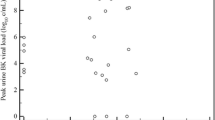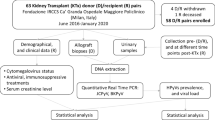Abstract
Polyomavirus BK (BKPyV) is ubiquitous among humans. Following primary infection, the virus remains latent predominantly in the hosts’ uroepithelial cells. Up to 10 % of renal transplant recipients show a viral reactivation that can lead to polyomavirus-associated nephropathy (PyVAN). In the absence of early treatments, the risk of graft loss is up to 80 %. Monitoring viral load in urine and plasma by real-time PCR after transplantation is the most common diagnostic tool to detect viral reactivation. In the present retrospective study, BKPyV-DNA loads in urine and plasma by quantitative real-time PCR were associated with clinical data, including HLA haplotype, blood parameters and viral genotype, of 40 renal transplant recipients at the University Clinics of Cologne. Seventeen out of 329 patients screened for BKPyV from January 2009 to October 2013 were detected BKPyV positive in urine only, whereas in 23 patients the virus became additionally detectable in plasma. Among these, ten patients progressed to PyVAN. Overall, the present study showed that the detection from the third month onwards after transplantation of a first viruric episode with a median viral load of 1 × 108 copies/mL, followed after few days by a first viremic episode with a median viral load of >1 × 104 copies/mL, was strongly associated with the development of PyVAN. In conclusion, the viral load and the temporal profile of the first viruric and viremic episode post-transplantation, in combination with specific features of the host immune response, should be considered as relevant clinical determinants of the risk of renal transplant recipients to progress to PyVAN.




Similar content being viewed by others
References
Gardner SD, Field AM, Coleman DV, Hulme B (1971) New human papovavirus (B.K.) isolated from urine after renal transplantation. Lancet 19:1253–1257. doi:10.1016/S0140-6736(71)90562-9
Jin L, Gibson PE, Booth JC, Clewley JP (1993) Genomic typing of BK virus in clinical specimens by direct sequencing of polymerase chain reaction products. J Med Virol 41:11–17
Zhong S, Randhawa PS, Ikegaya H, Chen Q, Zheng HY, Suzuki M, Takeuchi T, Shibuya A, Kitamura T, Yogo Y (2009) Distribution patterns of BK polyomavirus (BKV) subtypes and subgroups in American, European and Asian populations suggest co-migration of BKV and the human race. J Gen Virol 90:144–152. doi:10.1099/vir.0.83611-0
Zheng HY, Nishimoto Y, Chen Q, Hasegawa M, Zg S, Ikegaya H, Ohno N, Sugimoto C, Takasaka T, Kitamura T, Yogo Y (2007) Relationships between BK virus lineages and human populations. Microbes Infect 9:204–213. doi:10.1016/j.micinf.2006.11.00
Chehadeh W, Nampoory MR (2013) Genotypic diversity of polyomaviruses circulating among kidney transplant recipients in Kuwait. J Med Virol 85:1624–1631. doi:10.1002/jmv.23639
Egli A, Infanti L, Dumoulin A, Buser A, Samaridis J, Stebler C, Gosert R, Hirsch HH (2009) Prevalence of polyomavirus BK and JC infection and replication in 400 healthy blood donors. J Infect Dis 199:837–846. doi:10.1086/597126
Hirsch HH (2005) BK virus: opportunity makes a pathogen. Clin Infect Dis 41:354–360. doi:10.1086/431488
Bennett SM, Broekema NM, Imperiale MJ (2012) BK polyomavirus: emerging pathogen. Microbes Infect 14:672–683. doi:10.1016/j.micinf.2012.02.002
van Aalderen MC, Heutinck KM, Huisman C, ten Berge IJM (2012) BK virus infection in transplant recipients: clinical manifestations, treatment options and the immune response. Neth J Med 70:172–183
Lautenschlager I, Jahnukainen T, Kardas P, Lohi J, Auvinen E, Mannonen L, Dumoulin A, Hirsch HH, Jalanko H (2014) A case of primary JC polyomavirus infection-associated nephropathy. Am J Transplant 14:2887–2892. doi:10.1111/ajt.12945
Randhawa P, Ramos E (2007) BK viral nephropathy: an overview. Transplant Rev 21:77–85. doi:10.1016/j.trre.2007.03.001
Bohl DL, Brennan DC (2007) BK virus nephropathy and kidney transplantation. Clin J Am Soc Nephrol 2:36–46. doi:10.2215/CJN.00920207
Hirsch HH, Randhawa P (2013) BK Polyomavirus in solid organ transplantation. Am J Transplant 13:179–188. doi:10.1111/ajt.12110
Burgos D, Jironda C, Martín M, González-Molina M, Hernández D (2010) BK-virus-associated Nephropathy. Nefrologia 30:613–617. doi:10.3265/Nefrologia.pre2010.Oct.10587
Bechert CJ, Schnadig VJ, Payne DA, Dong J (2010) Monitoring of BK viral load in renal allograft recipients by real-time PCR assays. Am J Clin Pathol 133:242–250. doi:10.1309/AJCP63VDFCKCRUUL
Hirsch HH, Brennan DC, Drachenberg CB, Ginevri F, Gordon J, Limaye AP, Mihatsch MJ, Nickeleit V, Ramos E, Randhawa P, Shapiro R, Steiger J, Suthanthiran M, Trofe J (2005) Polyomavirus-associated nephropathy in renal transplantation: interdisciplinary analyses and recommendations. Transplantation 79:1277–1286. doi:10.1097/01.TP.0000156165.83160.09
Liptak P, Kemeny E, Ivanyi B (2006) Primer: histopathology of polyomavirus-associated nephropathy in renal allografts. Nat Clin Pract Nephrol 2:631–636. doi:10.1038/ncpneph0319
Sessa A, Esposito A, Giliberti A, Bergallo M, Costa C, Rossano R, Lettieri E, Capuano M (2008) BKV reactivation in renal transplant recipients: diagnostic and therapeutic strategy—case reports. Transplant Proc 40:2055–2058. doi:10.1016/j.transproceed.2008.05.007
Wu C, Randhawa P, McCauley J (2006) Transplantation: polyomavirus nephropathy and the risk of specific immunosuppression regimens. Sci World J 28:512–528. doi:10.1100/tsw.2006.93
Zeng Y, Magil A, Hussaini T, Yeung CK, Erb SR, Marquez-Alazagara V, Yoshida EM (2015) First confirmed case of native polyomavirus BK nephropathy in a liver transplant recipient seven years post-transplant. Ann Hepatol 14:137–140
Khamash HA, Wadei HM, Mahale AS, Larson TS, Stegall MD, Cosio FG, Griffin MD (2007) Polyomavirus-associated nephropathy risk in kidney transplants: the influence of recipient age and donor gender. Kidney Int 71:1302–1309. doi:10.1038/sj.ki.5002247
Ramos E, Drachenberg CB, Papadimitriou JC, Hamze O, Fink JC, Klassen DK, Drachenberg RC, Wiland A, Wali R, Cangro CB, Schweitzer E, Bartlett ST, Weir MR (2002) Clinical course of polyoma virus nephropathy in 67 renal transplant patients. J Am Soc Nephrol 13:2145–2151. doi:10.1097/01.ASN.0000023435.07320.81
Sharif A, Alachkar N, Bagnasco S, Geetha D, Gupta G, Womer K, Arend L, Racusen L, Montgomery R, Kraus E (2012) Incidence and outcomes of BK virus allograft nephropathy among ABO- and HLA-incompatible kidney transplant recipients. Clin J Am Soc Nephrol 7:1320–1327. doi:10.2215/CJN.00770112
Comoli P, Hirsch HH, Ginevri F (2008) Cellular immune responses to BK virus. Curr Opin Org Transplant 13:569–574. doi:10.1097/MOT.0b013e3283186b93
Weist BJ, Schmueck M, Fuehrer H, Sattler A, Reinke P, Babel N (2014) The role of CD4 + T cells in BKV-specific T cell immunity. Med Microbiol Immunol 203:395–408. doi:10.1007/s00430-014-0348-z
Masutani K, Ninomiya T, Randhawa P (2013) HLA-A2, HLA-B44 and HLA-DR15 are associated with lower risk of BK viremia. Nephrol Dial Transplant 28:3119–3126. doi:10.1093/ndt/gft298
Bohl DL, Storch GA, Ryschkewitsch C, Gaudreault-Keener M, Schnitzler MA, Major EO, Brennan DC (2005) Donor origin of BK virus in renal transplantation and role of HLA C7 in susceptibility to sustained BK viremia. Am J Transplant 5:2213–2221. doi:10.1111/j.1600-6143.2005.01000.x
Dugan AS, Gasparovic ML, Tsomaia N, Mierke DF, O’Hara BA, Manley K, Atwood WJ (2007) Identification of amino acid residues in BK virus VP1 that are critical for viability and growth. J Virol 81:11798–11808. doi:10.1128/JVI.01316-07
Tremolada S, Delbue S, Castagnoli L, Allegrini S, Miglio U, Boldorini R, Elia F, Gordon J, Ferrante P (2010) Mutations in the external loops of BK virus VP1 and urine viral load in renal transplant recipients. J Cell Physiol 222:195–199. doi:10.1002/jcp.21937
Krautkrämer E, Klein TM, Sommerer C, Schnitzler P, Zeier M (2009) Mutations in the BC-Loop of the BKV VP1 region do not influence viral load in renal transplant patients. J Med Virol 81:75–81. doi:10.1002/jmv.21359
Boldorini R, Veggiani C, Turello E, Barco D, Monga G (2005) Are sequence variations in the BK virus control region essential for the development of polyomavirus nephropathy? Am J Clin Pathol 124:303–312. doi:10.1309/RLB1PMV33RK7CGAX
Boldorini R, Allegrini S, Miglio U, Paganotti A, Veggiani C, Mischitelli M, Monga G, Pietropaolo V (2009) Genomic mutations of viral protein 1 and BK virus nephropathy in kidney transplant recipients. J Med Virol 81:1385–1393. doi:10.1002/jmv.21520
Krumbholz A, Zell R, Egerer R, Sauerbrei A, Helming A, Gruhn B, Wutzler P (2006) Prevalence of BK virus subtype I in Germany. J Med Virol 78:1588–1598. doi:10.1002/jmv.20743
Bárcena-Panero A, Van Ghelue M, Khan MT, Echevarría JE, Fedele G, Moens U (2012) BK virus-associated infection in cerebrospinal fluid of neurological patients and mutation analysis of the complete VP1 gene in different patient groups. J Cell Physiol 227:136–145. doi:10.1002/jcp.22711
Kuppachi S, Thomas B, Kokko KE (2013) BK virus in the kidney transplant patient. Am J Med Sci 345:482–488. doi:10.1097/MAJ.0b013e31826c64ef
Drachenberg CB, Papadimitriou JC (2006) Polyomavirus-associated nephropathy: update in diagnosis. Trans Infect Dis 8:68–75. doi:10.1111/j.1399-3062.2006.00154.x
Drachenberg CB, Papadimitriou JC, Hirsch HH, Wali R, Crowder C, Nogueira J, Cangro CB, Mendley S, Mian A, Ramos E (2004) Histological patterns of polyomavirus nephropathy: correlation with graft outcome and viral load. Am J Transplant 4:2082–2092. doi:10.1046/j.1600-6143.2004.00603.x
Randhawa P, Ho A, Shapiro R, Vats A, Swalsky P, Finkelstein S, Uhrmacher J, Weck K (2004) Correlates of quantitative measurement of BK polyomavirus (BKV) DNA with clinical course of BKV infection in renal transplant patients. J Clin Microbiol 42:1176–1180. doi:10.1128/JCM.42.3.1176-1180.2004
Babel N, Fendt J, Karaivanov S, Bold G, Arnold S, Sefrin A, Lieske E, Hoffzimmer M, Dziubianau M, Bethke N, Meisel C, Grütz G, Reinke P (2009) Sustained BK viruria as an early marker for the development of BKV-associated nephropathy: analysis of 4128 urine and serum samples. Transplantation 88:89–95. doi:10.1097/TP.0b013e3181aa8f62
Hasegawa M, Ito T, Saigo K, Akutsu N, Maruyama M, Otsuki K, Aoyama H, Matsumoto I, Asano T, Kitamura H, Kenmochi T (2014) Association of DNA amplification with progress of BK polyomavirus infection and nephropathy in renal transplant recipients. Transplant Proc 46:556–559. doi:10.1016/j.transproceed.2013.11.114
Viscount HB, Eid AJ, Espy MJ, Griffin MD, Thomsen KM, Harmsen WS, Razonable RR, Smith TF (2007) Polyomavirus polymerase chain reaction as a surrogate marker of polyomavirus associated-nephropathy. Transplantation 84:340–345. doi:10.1097/01.tp.0000275205.41078.51
Hirsch HH, Knowles W, Dickenmann M, Passweg J, Klimkait T, Mihatsch MJ, Steiger J (2002) Prospective study of polyomavirus type BK replication and nephropathy in renal-transplant recipients. N Engl J Med 347:488–496
Conflict of interest
The authors declare that there is no conflict of interests regarding the publication of this paper.
Author information
Authors and Affiliations
Corresponding author
Rights and permissions
About this article
Cite this article
Teutsch, K., Schweitzer, F., Knops, E. et al. Early identification of renal transplant recipients with high risk of polyomavirus-associated nephropathy. Med Microbiol Immunol 204, 657–664 (2015). https://doi.org/10.1007/s00430-015-0398-x
Received:
Accepted:
Published:
Issue Date:
DOI: https://doi.org/10.1007/s00430-015-0398-x




